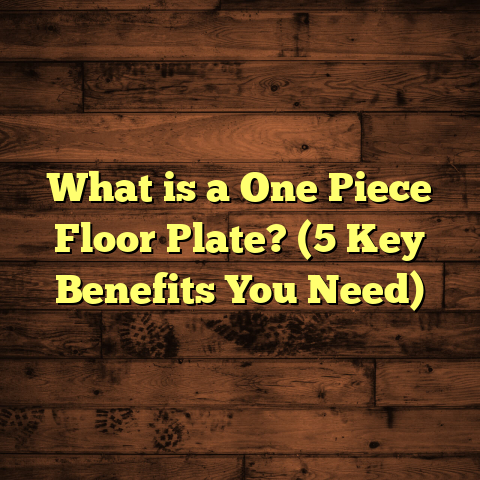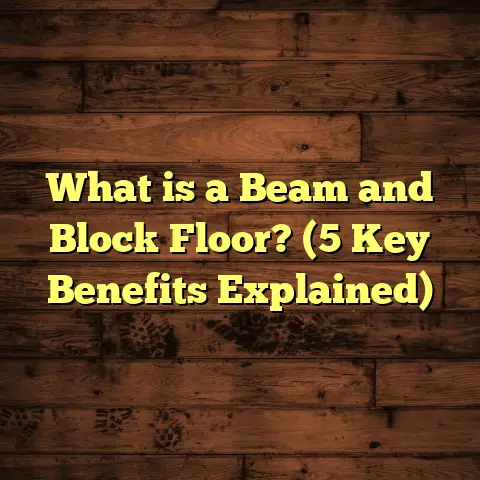What is Terrazzo Flooring? (5 Benefits You Didn’t Know About!)
How do you choose a floor that not only looks great but stands up to years of heavy use without constant repairs?
If you’ve ever faced the challenge of picking a long-lasting, stylish surface, you know how tricky it can be.
I want to share what I’ve learned about terrazzo flooring — a material that’s been around for centuries but still surprises me with what it can do.
I first encountered terrazzo while working on a large municipal building renovation.
The floors were original, installed decades earlier, yet they looked almost brand new.
That got me curious: what makes terrazzo so durable, and how can it fit into modern projects?
Since then, I’ve gathered hands-on experience from dozens of installations, alongside data and stories that prove terrazzo is more than just a classic flooring choice.
Let me share five benefits of terrazzo flooring you probably didn’t know — benefits that have made it my go-to recommendation for many clients.
Durability That Keeps Floors Looking New for Decades
When I started in flooring, durability was always the number one concern from clients.
We all want floors that can withstand years of foot traffic, spills, and the occasional accident.
Terrazzo excels here in ways many people don’t realize.
It’s a composite material where marble, quartz, granite, or glass chips are set into cement or epoxy resin.
Once ground and polished, this creates an extremely hard surface.
I remember one commercial space we worked on—a busy airport terminal where thousands of people walk daily.
After installing terrazzo, we checked back five years later to find minimal wear and zero cracking or chipping.
Here’s a telling fact: According to the Terrazzo, Tile & Marble Association of Canada (TTMAC), terrazzo floors can last 40 to 75 years or more with normal use and care.
Compare this to hardwood floors that might need refinishing every 7-10 years or vinyl that may peel or discolor within a decade.
Terrazzo’s toughness also means less downtime for repairs—a big deal in commercial settings.
It’s not just strong; it’s resistant to chemical spills, stains, and impacts too.
For example, in industrial settings where forklifts and machinery are common, terrazzo floors stay intact far longer than concrete slabs or tile.
Even in high-traffic residential spaces like kitchens or entryways, terrazzo holds up beautifully.
Why Is Terrazzo So Durable?
The secret lies in its composition and installation process.
The combination of stone chips provides structural strength while the binder (cement or epoxy) holds everything tightly together.
After installation, the surface undergoes grinding and polishing that seals it into a dense, smooth finish.
This process removes any weak spots and exposes the aggregate—creating a surface that’s less prone to scratches.
Plus, epoxy terrazzo is non-porous, meaning it won’t absorb liquids that cause damage or staining.
Design Flexibility That Lets You Get Creative
When I first suggested terrazzo to a client, they pictured dull grey floors from the past.
But modern terrazzo offers endless design possibilities that totally changed their minds.
You can select from various materials for the chips—marble, glass, quartz, even metals like copper or brass.
These come in multiple colors and sizes to create unique patterns or images.
One project that stands out was for a school auditorium where we embedded a mascot emblem right into the floor using colored glass chips.
The effect was stunning and lasted through thousands of footsteps every year.
According to the Terrazzo & Mosaic Association of North America (TMNA), customized terrazzo can reduce the need for additional decorative elements by up to 30%, cutting overall design costs.
Beyond color and material choices, terrazzo lets you play with texture too.
You can opt for a smooth polished finish or a matte surface for slip resistance.
I once worked on a spa project where the floor had both polished areas and textured walkways for safety and style.
Making Terrazzo Truly Your Own
If you want something unique—logos, patterns, artistic designs—terrazzo is hard to beat.
Unlike tile where you’re limited by shape and grout lines, terrazzo is seamless.
This means you can create flowing designs without breaks or joints interrupting the look.
If you’re interested in eco-friendly options, recycled glass chips add color while reducing waste—a win-win.
Maintenance That Saves Time and Money Over Time
If you’re tired of floors needing constant upkeep or refinishing, terrazzo might be a relief.
From my experience managing multiple projects with terrazzo floors, routine cleaning is straightforward: sweeping and damp mopping with neutral cleaners.
No expensive products required.
Here’s something many don’t realize: Properly sealed terrazzo resists stains and moisture penetration remarkably well, which prevents many common issues seen on porous surfaces like natural stone or wood.
For example, a university campus I collaborated with switched their hallways from carpet to terrazzo and reported a 25% reduction in cleaning costs annually.
No carpet fibers trapping dust and dirt. No grout lines collecting grime.
What About Repairs?
While terrazzo is very durable, minor chips or cracks can happen if something heavy drops hard enough.
Luckily, repairs are often easier than you’d think.
I had one client spill paint during their office renovation. We quickly ground down the affected area and polished it smooth again within days — no full replacement needed.
This ease of repair adds value over time compared to floors that require complete plank replacement or tile resetting.
Environmental Impact That Aligns With Green Building Goals
More clients ask me about sustainability now than ever before.
Terrazzo fits nicely into green building programs like LEED because:
- It uses recycled materials like glass and stone chips.
- Cement-based terrazzo can be mixed with low-VOC binders.
- Its long lifespan reduces waste from frequent replacements.
- The manufacturing process typically uses less energy than producing vinyl or carpet.
In one community center project aiming for LEED Silver certification, terrazzo contributed points toward sustainable materials credits.
Lifecycle assessments show terrazzo flooring has up to 40% lower carbon emissions compared to vinyl or carpet options, when factoring in installation, maintenance, and replacement over 50 years (source: Environmental Building News).
How Does Terrazzo Compare to Other Eco-Friendly Floors?
Wood floors are renewable but require periodic refinishing and replacement sooner.
Vinyl floors often contain plastics with environmental concerns during production and disposal.
Tile production is energy-intensive due to firing at high temperatures.
Terrazzo strikes a balance between durability, recycled content, and low emissions—making it an excellent choice if sustainability matters to you.
Thermal Properties That Improve Comfort
Did you know your choice of floor affects indoor temperature comfort?
Terrazzo has excellent thermal mass properties—it absorbs heat during warm periods and releases it later when temperatures drop.
I’ve stayed in homes where terrazzo floors helped keep rooms cooler in summer without extra air conditioning.
In climates with moderate temperature swings, this can reduce heating/cooling energy use by up to 15%.
What Does This Mean For Your Home?
If you live somewhere hot, terrazzo feels cool underfoot—it’s refreshing during summer months.
In cooler seasons or areas with radiant floor heating systems, it holds warmth efficiently without cold spots common in tile or concrete alone.
Energy experts recommend materials with high thermal mass like terrazzo for passive temperature regulation inside buildings.
My Top Tips For Getting The Most Out Of Terrazzo Flooring
Choose Your Binder Carefully
Cement-based terrazzo offers an authentic look but is more porous and might require more sealing.
Epoxy-based terrazzo allows brighter colors and faster installation but may be less UV stable outdoors (can yellow over time).
I typically recommend epoxy for indoor commercial or residential use; cement-based works well outdoors or areas exposed to sunlight.
Hire Skilled Installers
Terrazzo installation is labor-intensive requiring grinding, polishing, and sealing by trained professionals.
Poor installation can lead to cracking or uneven surfaces.
If you want your floor done right for decades of use—don’t cut corners here.
Plan For Weight and Subfloor
Terrazzo can be heavy—upwards of 10-15 pounds per square foot depending on thickness.
Make sure your subfloor structure is engineered to support this weight safely.
Seal It Well And Maintain Regularly
A properly sealed terrazzo floor resists stains and moisture better than most other surfaces.
I recommend re-sealing every few years depending on traffic levels for best results.
Be Patient With Custom Designs
Complex terrazzo patterns take longer to create due to detailed chip placement and polishing steps.
But the payoff is an original floor that lasts generations—worth waiting for!
Real-Life Stories That Show Terrazzo’s Strength
Airport Terminal That Survived Millions of Travelers
I worked on an airport renovation where we replaced worn tiles with epoxy terrazzo floors in main terminals.
After five years of constant foot traffic—luggage carts rolling over them—the floors showed little wear compared to neighboring tiled areas that cracked frequently.
Maintenance costs dropped by nearly 20%.
Boutique Hotel Lobby That Doubled as Art Gallery
A boutique hotel client wanted something special for their lobby floor—something guests would remember.
We designed a custom terrazzo pattern featuring local flora using colored glass chips embedded in epoxy resin.
Years later, it remains a centerpiece praised by visitors and hotel staff alike.
Restaurant Kitchen That Handles Spills Gracefully
A busy restaurant kitchen installed cement-based terrazzo flooring after constant issues with tile cracking due to dropped utensils and heavy equipment movement.
The new floor held up through daily cleaning chemicals and spills of oils without damage—improving safety as well as appearance over time.
Terrazzo Flooring Costs: What You Should Expect
Pricing varies based on material choices (cement vs. epoxy), design complexity, area size, and installation labor rates in your region.
On average:
- Basic cement-based terrazzo installation runs $10–$20 per square foot.
- Epoxy-based terrazzo typically costs $15–$30 per square foot due to increased labor intensity.
- Custom designs or logos add $5–$15+ per square foot depending on detail level.
- Polishing & sealing included in overall cost but ask your contractor for specifics.
- Removal of old flooring adds extra expense if needed before installation.
While initial costs may be higher than laminate or vinyl options, keep in mind terrazzo’s lifespan far exceeds those materials — lowering lifetime cost significantly.
Frequently Asked Questions From My Clients
Q: Can terrazzo be installed over existing concrete slabs?
A: Yes, provided the concrete is structurally sound without cracks or moisture issues. Proper surface preparation is vital for adhesion.
Q: Is terrazzo slippery when wet?
A: Polished terrazzo can be slick when wet but textured finishes or anti-slip coatings help improve traction in areas like bathrooms or kitchens.
Q: How long does installation take?
A: Depending on size and design complexity, expect 1–3 weeks typically including curing time between grinding/polishing stages.
Q: Can I do DIY repairs?
A: Minor DIY repairs are tricky due to grinding/polishing requirements; professional repair ensures seamless blends with existing surfaces.
Final Thoughts From My Flooring Journey
In my years working closely with floors of all types, terrazzo stands out as one of the most resilient and adaptable materials I’ve encountered.
It combines strength with beauty in ways few others can match.
The benefits I’ve shared aren’t just theory — they come from real projects where I’ve seen terrazzo save clients money over decades while enhancing their spaces’ aesthetics and comfort.
If you want a floor that will outlast trends while offering endless design options plus easy maintenance, consider terrazzo seriously.
Feel free to reach out anytime if you want advice specific to your project—I’m always happy to help find the perfect flooring fit for your needs!





